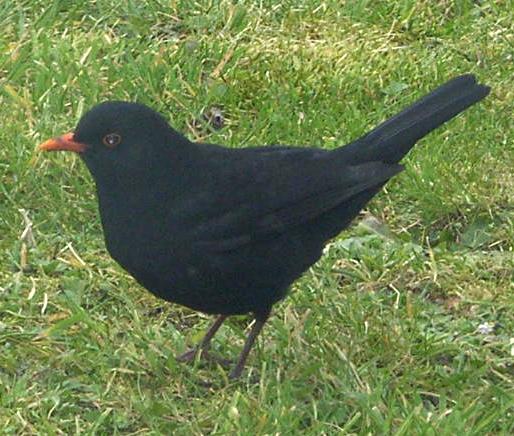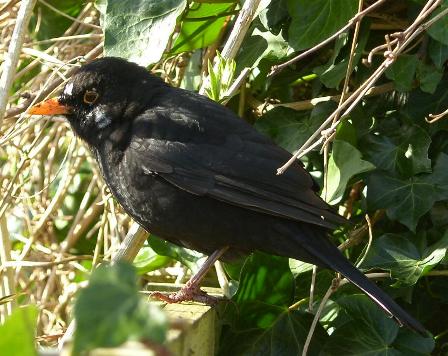Blackbird
Scientific name: Turdus merula

A male Blackbird with its distinctive orange bill and eye-ring.
Blackbirds are most often seen in the morning or near dusk, as they pick around in the undergrowth for grubs and snails - though this forms only a small part of their diet, the main one being various fruits. They can often be seen on the lawn with their head cocked to one side, which some say is listening for worms, but they have to tilt their head to see the ground due to the position of their eyes. Unfortunately for tidy gardeners their foraging can be very messy as dead leaves and mulches are scattered around. They sweep their head from side to side using their bill like a plough to expose grubs and slugs. In newly planted flowerbeds where the mulch is preventing weed seeds from germinating, the effect is lost when soil is brought to the surface. Annoyingly newly planted young specimens can be dislodged, also they pull up plant labels and discard them. On the lawn the grass, moss and thatch they pull up is untidy as well.
The male has all-black plumage with a distinctive yellow bill and eye-ring. The female has a brown bill with brown plumage and a mottled breast and underbelly - similar to a Thrush, though darker. Young males are similar to females and gradually darken to their adult plumage after about a year.

A female Blackbird
Until about 100 years ago blackbirds inhabited mainly woodland areas, but since then they have moved to gardens, fields, parks and commons. Now they are probably the most widespread birds in the British Isles. They are the main component of the dawn chorus and some rate their fluting song as highly as that of the nightingale. In times of danger when they spot a predatory bird or a cat, they have a harsh 'chook-chook' call.

This male Blackbird has not been splashed with paint, it is showing the characteristic known as leucism. This can occur throughout the animal kingdom where the plumage or fur can vary from white blotches to being completely white due to the failure of pigment production in skin cells. This is different to albinism where only melanin is missing.
In the spring the males are very territorial and can be seen in chase flights with other birds. At this time decorative mirrors can cause casualties or even fatalities as they crash into them, so they should be covered.
To prevent the bark mulch from being scattered, try placing some twigs over it, they do not find it easy to work among them so go elsewhere; or pin strips of pond netting on the surface of the mulch along the edges where it will be tossed onto paths or the lawn. Keep the base of hedges cleared of leaf debris, this also reduces hiding places for slugs.
Back to GARDEN CREATURES

